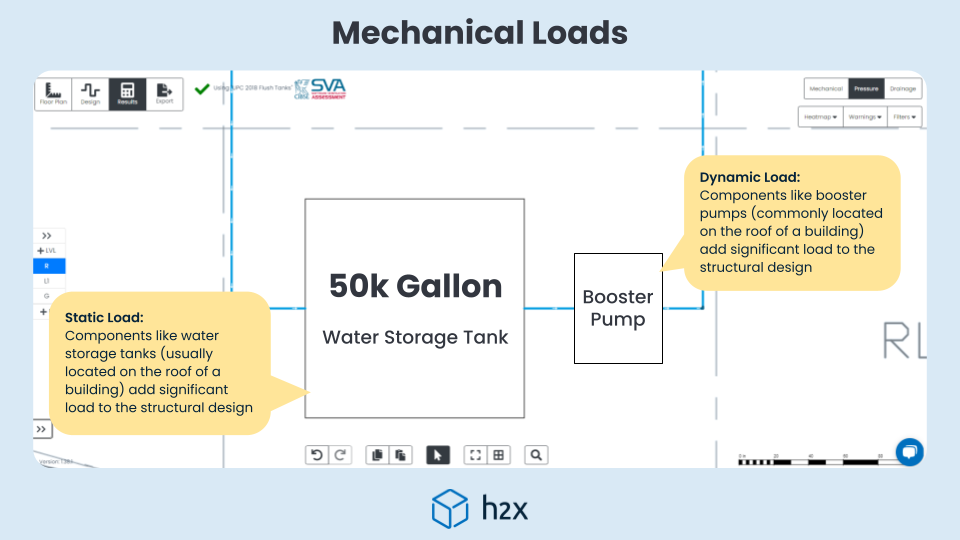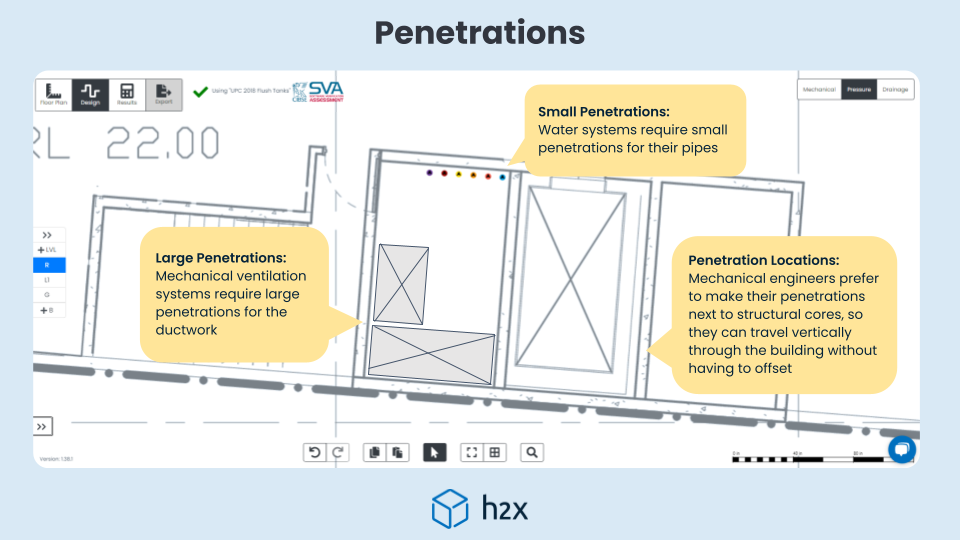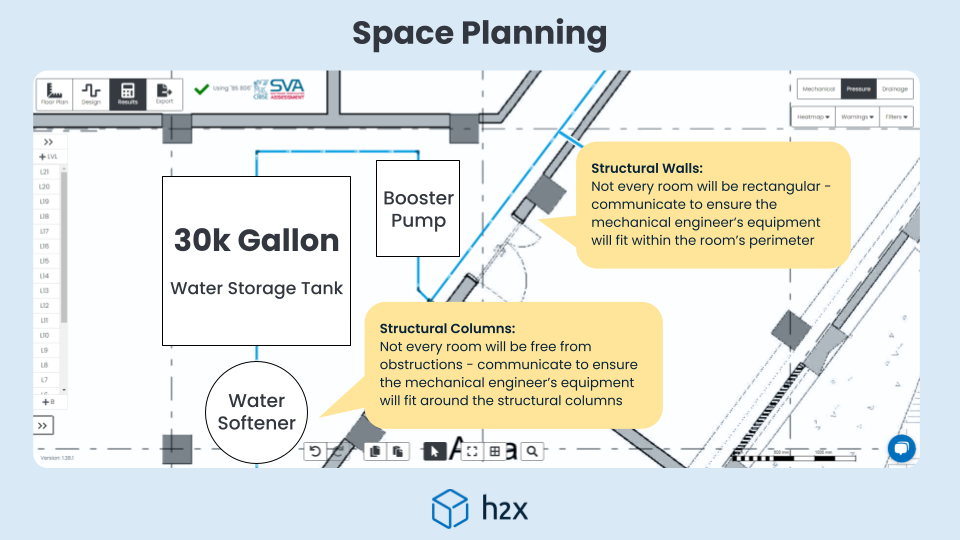In qualsiasi progetto di costruzione, due discipline si distinguono per il loro impatto sulla forma e sulla funzionalità di un edificio: ingegneria strutturale e meccanica. Mentre l'ingegneria strutturale garantisce che l'edificio sia forte e stabile, l’ingegneria meccanica integra sistemi che forniscono servizi essenziali come il riscaldamento, raffreddamento, e idraulico. Anche se distinto, questi campi spesso si sovrappongono, rendendo vitale il loro coordinamento. Passi falsi o problemi di comunicazione possono portare a costosi ritardi, revisioni progettuali, o anche problemi di sicurezza.
Questo blog approfondisce le principali intersezioni di queste discipline, evidenziando le sfide e le soluzioni nell’armonizzazione delle loro esigenze. In collaborazione con Ingegneria h2x, esploriamo cinque passaggi chiave che si tradurranno in edifici robusti ed efficienti.
Comunicazione: Il collegamento essenziale nella progettazione edilizia
Al suo centro, la comunicazione in costruzione trascende il mero dialogo. È l’intricato scambio di dati tecnici, intento progettuale, vincoli, e feedback. Data la natura dei progetti di costruzione moderni, dove convergono diverse specialità, comunicare informazioni accurate è fondamentale. Ingegneri strutturali e meccanici, pur operando in ambiti diversi, influenzano profondamente il lavoro degli altri. Una corretta comunicazione garantisce che le decisioni di progettazione siano informate, pratico, e sinergico.
Esempio ipotetico:
Consideriamo un museo futuristico, progettato con ampie curve e vasti spazi aperti, progettando di ospitare una mostra a controllo ambientale per manufatti delicati. Il team strutturale prevede un particolare tipo di cemento armato per ottenere l'estetica desiderata. Contemporaneamente, il team meccanico ha individuato la necessità di condutture estese per controllare il clima della mostra. Senza una comunicazione chiara, il team strutturale potrebbe finalizzare progetti che non supportano questa canalizzazione. Questa svista potrebbe portare a costose riprogettazioni, compromessi nell'intento estetico, o addirittura inefficienze nel sistema di climatizzazione.
Informazioni richieste dall'ingegnere strutturale:
- Progetti preliminari ed esecutivi di sistemi meccanici, evidenziandone le esigenze di spazio e di carico.
- Vincoli o sfide previsti dal team meccanico, come esigenze specifiche di controllo delle vibrazioni o espansioni legate alla temperatura.
- Aggiornamenti regolari man mano che la progettazione meccanica si evolve, garantire che i cambiamenti in fase avanzata non entrino in conflitto con i piani strutturali stabiliti.
Informazioni richieste dall'ingegnere meccanico:
- Disposizioni strutturali dettagliate che indicano gli elementi portanti primari, zone di flessibilità, e aree con accesso limitato o potenziale di modifica.
- Approfondimenti su potenziali cambiamenti strutturali, adattamenti, o innovazioni che potrebbero influenzare la progettazione meccanica o il routing.
- Circuiti di feedback per la collaborazione iterativa, consentendo al team meccanico di adattare i progetti in risposta al feedback strutturale.
Carichi meccanici: Decifrare le forze statiche e dinamiche
Al centro della progettazione strutturale si trova il compito di accogliere i carichi. Mentre i carichi morti (dalla struttura stessa) e carichi vivi (dagli occupanti e dagli arredi) sono considerazioni fondamentali, i carichi meccanici aggiungono un ulteriore livello di complessità.
 Questi possono essere classificati in:
Questi possono essere classificati in:
- Carichi statici: Questo è il peso immutabile o la forza esercitata da un'apparecchiatura meccanica fissa, come il peso di un'unità di trattamento aria.
- Una guida su come applicare carichi sismici ed eseguire un'analisi dello spettro di risposta in S3D: Si tratta di forze variabili o sollecitazioni aggiuntive introdotte dal funzionamento di sistemi meccanici. Spesso si verificano a causa di parti in movimento all'interno del sistema, fluttuazioni dell’intensità operativa, o anche le sequenze di avvio e spegnimento.
Sistemi meccanici, per loro natura, possedere peso (carichi statici) e hanno caratteristiche operative che generano forze (carichi dinamici). Una stazione di pompaggio, per esempio, pur avendo un peso fisso, creerà anche forze quando le pompe si attivano, spingendo l'acqua in un edificio.
Esempio ipotetico:
Consideriamo un grattacielo residenziale che incorpora una grande unità di trattamento dell'aria. L'attrezzatura, ospitato nella parte superiore dell'edificio, conferisce un carico statico costante all'edificio. Tuttavia, mentre il sistema funziona, introduce forze dinamiche, variabile in base alla velocità di funzionamento. Se queste forze dinamiche si allineano con la frequenza naturale dell’edificio, potrebbero causare vibrazioni risonanti, portando potenzialmente ad un affaticamento strutturale accelerato o addirittura ad un’oscillazione percettibile.
Informazioni richieste dall'ingegnere strutturale:
- Schede tecniche complete di tutte le attrezzature meccaniche, peso dettagliato, caratteristiche operative, e qualsiasi forza ciclica o transitoria prevista durante il funzionamento.
- Punto di applicazione di questi carichi, che potrebbe influenzare il modo in cui le forze sono distribuite tra gli elementi strutturali.
- Informazioni sulle potenziali variazioni di questi carichi, come i cambiamenti stagionali nelle operazioni HVAC o la variazione dei modelli di utilizzo degli ascensori durante il giorno.
Informazioni richieste dall'ingegnere meccanico:
- Dati sugli elementi strutturali’ capacità portanti, garantire che il posizionamento delle apparecchiature rispetti questi limiti.
- Feedback sulle frequenze di risonanza strutturale o qualsiasi altro vincolo che potrebbe influenzare il funzionamento o il posizionamento del sistema meccanico.
- Informazioni su eventuali modifiche o aggiornamenti strutturali pianificati che potrebbero influire sulle prestazioni o sull'integrazione del sistema meccanico.
Penetrazioni: La coreografia della struttura e dei sistemi meccanici
Le penetrazioni rappresentano le aperture o i percorsi intenzionali creati all'interno degli elementi strutturali per accogliere i sistemi meccanici. Possono essere qualsiasi cosa, dai piccoli fori per i condotti elettrici alle aperture più grandi per i condotti HVAC o gli impianti idraulici. Poiché gli edifici mirano ad essere più integrati e compatti, nasce la necessità che i sistemi meccanici attraversino componenti strutturali. Che si tratti di garantire un layout ottimizzato, mantenere l'estetica, o semplicemente fornire servizi essenziali in tutto l'edificio, queste penetrazioni diventano una parte cruciale del processo di progettazione.

Esempio ipotetico:
Immagina un edificio per uffici di lusso con particolare attenzione agli spazi aperti e al design minimalista. Per mantenere questa estetica, Si prevede che i condotti HVAC attraversino le travi primarie dell'edificio, che richiedono penetrazioni consistenti. Se queste penetrazioni non vengono adeguatamente prese in considerazione durante la progettazione, potrebbero compromettere le travi’ capacità portante. Col tempo, queste travi compromesse potrebbero presentare segni di stress, come crepe o deflessioni eccessive, potenzialmente mettendo in pericolo l’integrità dell’edificio.
Informazioni richieste dall'ingegnere strutturale:
- Disposizioni meccaniche dettagliate che indicano le penetrazioni richieste, le loro dimensioni, e posizioni.
- Eventuali variazioni o aggiustamenti a queste penetrazioni, come opzioni di instradamento alternative o flessibilità nel loro dimensionamento.
- Requisiti meccanici, come isolamenti o rivestimenti protettivi, che potrebbero influenzare la dimensione o la natura della penetrazione.
Informazioni richieste dall'ingegnere meccanico:
- Progetti strutturali e dettagli, evidenziando gli elementi portanti critici e le zone di elevata importanza strutturale.
- Vincoli o linee guida relativi alle penetrazioni, come le dimensioni massime consentite o le posizioni da evitare.
- Feedback su eventuali rinforzi o modifiche strutturali, che potrebbe offrire maggiore flessibilità nel routing meccanico.
Vibrazioni: Oscillazioni da sistemi meccanici
Le vibrazioni rappresentano le oscillazioni o i movimenti ritmici all'interno degli elementi costruttivi, spesso innescato o intensificato da sistemi meccanici. Mentre alcune vibrazioni sono benigne, altri possono essere abbastanza potenti da causare disagio, compromettere l’integrità strutturale, o addirittura incidere sulla longevità dei componenti sia strutturali che meccanici. Nell'ambiente costruito, le vibrazioni sono un fenomeno naturale, derivanti da varie fonti come il vento, attività sismica, o occupazione umana. Tuttavia, sistemi meccanici, grazie al loro design e funzionalità intrinseci, spesso introducono vibrazioni aggiuntive.
Esempio ipotetico:
Immagina una sala da concerto, rinomato per la sua acustica incontaminata. Per mantenere un livello di temperatura e umidità ideale, un potente sistema HVAC opera in background. Tuttavia, quando questo sistema si avvia, introduce vibrazioni che viaggiano attraverso la struttura dell’edificio. Queste vibrazioni, anche se sottile, interferire con l'acustica della sala durante i passaggi musicali silenziosi. Senza un coordinamento preventivo tra ingegneri strutturali e meccanici, la sala potrebbe trovarsi ad affrontare delle sfide nel fornire la qualità del suono per cui è famosa.
Informazioni richieste dall'ingegnere strutturale:
- Specifiche dettagliate di tutte le attrezzature meccaniche, soprattutto quelli con carichi dinamici elevati o componenti rotanti.
- I programmi operativi e i modelli di frequenza offrono informazioni su quando e con quale frequenza potrebbero verificarsi queste vibrazioni.
- Eventuali disposizioni di progettazione meccanica già in atto per smorzare o controllare le vibrazioni, come isolatori o tecniche di montaggio specifiche.
Informazioni richieste dall'ingegnere meccanico:
- Le frequenze naturali dell’edificio e le eventuali zone conosciute sono particolarmente sensibili alle vibrazioni.
- Misure strutturali o materiali che smorzano intrinsecamente le vibrazioni o disperdono i carichi dinamici.
- Feedback su eventuali interventi strutturali, come smorzatori di massa accordati o rinforzi aggiunti, potrebbero influenzare la progettazione meccanica o il posizionamento.
Pianificazione dello spazio: Scolpire l'armonia tra funzione e forma
La pianificazione dello spazio approfondisce l'allocazione, organizzazione, un
d utilizzo efficiente dello spazio fisico all'interno di un edificio. Si tratta di orchestrare il modo in cui i componenti strutturali coesistono con i sistemi meccanici, il tutto garantendo una funzionalità ottimale e preservando la visione architettonica. Gli edifici sono molto più che semplici rifugi; sono ambienti orchestrati su misura per usi specifici, estetica, ed esperienze. Come tale, ogni centimetro di spazio conta. Il quadro strutturale fornisce il sostegno necessario, mentre i sistemi meccanici offrono servizi essenziali come la ventilazione, idraulico, e potere. La necessità di ospitarli entrambi senza compromessi richiede una meticolosa pianificazione degli spazi.
Esempio ipotetico:
Visualizza un resort termale di lusso progettato con soffitti aperti per enfatizzare la tranquillità e l'apertura. Ma man mano che i progetti avanzano, si è scoperto che il sistema HVAC richiede condotti di grandi dimensioni, quale, se non attentamente integrato, potrebbe appendere vistosamente, disturbare l'atmosfera desiderata. Se gli ingegneri strutturali e meccanici non si fossero coordinati fin dall’inizio, il risultato potrebbe essere una progettazione compromessa o una costosa riprogettazione del sistema HVAC.
Informazioni richieste dall'ingegnere strutturale:
- Disposizioni dettagliate e dimensioni dei sistemi meccanici, permettendo una comprensione delle loro esigenze spaziali.
- Potenziale flessibilità o adattabilità nel routing meccanico, che potrebbero offrire soluzioni in spazi ristretti o in zone di pregio architettonico.
- Scalabilità futura o modifiche nei sistemi meccanici, garantire che la struttura possa ospitare potenziali aggiornamenti.
Informazioni richieste dall'ingegnere meccanico:
- Piani strutturali con aree evidenziate di elevata importanza, vincoli, o accesso limitato, guidare le decisioni di progettazione meccanica.
- Informazioni su eventuali caratteristiche strutturali o materiali che potrebbero influenzare le prestazioni del sistema meccanico, come zone termicamente isolate o aree con maggiore insonorizzazione.
- Feedback su potenziali modifiche strutturali che potrebbero offrire più spazio o migliori opportunità di integrazione.
Conclusione
Nell'intricato mondo dell'edilizia, il coordinamento dei sistemi strutturali e meccanici è la chiave del successo. Come abbiamo esplorato, questa interazione modella l’essenza stessa del nostro ambiente costruito, garantendo non solo la robustezza delle nostre strutture ma anche la funzionalità che le dà vita. Entrambe le discipline, sebbene distinti nei loro principi fondamentali, si intersecano in modi che richiedono una comunicazione chiara, lungimiranza, e competenza collaborativa.



